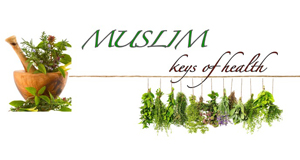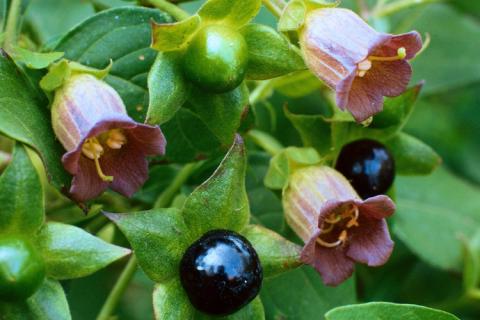BELLADONNA
(Atropa belladonna)
Don’t be deceived by beautiful purple flowers, dark green leaves, and sweet tasting berries! Belladonna is one of the most poisonous herbs in the world. For centuries it has been a weapon of choice for murders and suicides.
This annual plant grows about 2 to 4 feet high and usually thrive in damp and shady spots. The entire plant—from its roots to its fruits—is toxic. Just brushing up against the plant can give you pustules. The most toxic part of the plant are the roots and the least toxic is the fruit. However, that by no means makes it safe to eat. Just two to three berries are enough to kill a child or an animal.
The plant’s toxicity comes from an alkaloid it contains called atropine. If consumed, this chemical causes a quickening of the pulse, confusion, seizures, hallucinations and even death. In fact, the symptoms of atropine are so horrid that it is often added to addictive painkillers to keep people from getting dependent. Belladonna has also been used as a recreational drug. Its effects start out as pleasurable but soon turn rough and frightening, often ending in permanent blindness, brain damage, and even death.
USES
The scary introduction probably makes you wonder how and why on earth is this herb still being used? It is a valid concern. Belladonna has been medicinally used for centuries and is still used today. It has chemicals that can block functions of the body’s nervous system. Some of the bodily functions regulated by the nervous system include salivation, sweating, pupil size, urination, digestive functions, and others.
Some of its uses include…
- It is an effective herb for the Nervous System. Belladonna is used to treat the rigidity, tremor, excessive salivation, and sweating caused by Parkinson’s Disease.
- It’s ointment can help with nerve disorders such as Sciatica and Neuralgia.
- Belladonna also is used to treat motion sickness, nausea, vomiting, abdominal cramping associated with menstruation
- It is used to reduce nighttime urination, mainly among children.
- It is effective for chronic headaches and migraines.
- It is effective in bringing down fever.
- It is beneficial in curing oral problems like toothache and mumps.
- It is highly effective in treating respiratory ailments such as asthma and whooping cough.
- Rectally, belladonna is used in hemorrhoid suppositories.
- It is helpful in curbing symptoms of menopause.
- It is a constituent in many skin creams for treating skin ailments, including ulcers.
- Belladonna is also used in plasters (medicine-filled gauze applied to the skin) for treating psychiatric disorders, a behavior disorder called hyperkinesis, excessive sweating (hyperhidrosis), and bronchial asthma.
HOW TO USE
Belladonna products are available for purchase over the counter at pharmacies and health food stores in the US. It is mainly used in homeopathic medicine. One large American manufacturer of homeopathic products even sells teething tablets and gels that contain belladonna. (Although the US FDA considers them unsafe).
Usually marketed as nutritional supplements, belladonna is sold in tablets, tincture (liquid), ointments, and in a pump spray.
Even though belladonna is easily available, it is highly advisable not to use it without consulting your natural healthcare practitioner first.
SPECIAL PRECAUTIONS & WARNINGS*
Pregnancy and Breastfeeding: Belladonna is LIKELY UNSAFE when taken by mouth during pregnancy. Belladonna contains potentially toxic chemicals and has been linked to reports of serious side effects. Belladonna is also LIKELY UNSAFE during breastfeeding. It can reduce milk production and also passes into breast milk.
Congestive heart failure (CHF): Belladonna might cause rapid heartbeat (tachycardia) and might make CHF worse.
Constipation: Belladonna might make constipation worse.
Down syndrome: People with Down syndrome might be extra-sensitive to the potentially toxic chemicals in belladonna and their harmful effects.
Esophageal reflux: Belladonna might make esophageal reflux worse.
Fever: Belladonna might increase the risk of overheating in people with fever.
Stomach ulcers: Belladonna might make stomach ulcers worse.
Gastrointestinal (GI) tract infections: Belladonna might slow emptying of the intestine, causing retention of bacteria and viruses that can cause infection.
Gastrointestinal (GI) tract blockage: Belladonna might make obstructive GI tract diseases (including atony, paralytic ileus, and stenosis) worse.
Hiatal hernia: Belladonna might make hiatal hernia worse.
High blood pressure: Taking large amounts of belladonna can increase blood pressure. This might make blood pressure become too high in people with high blood pressure.
Narrow-angle glaucoma: Belladonna might make narrow-angle glaucoma worse.
Psychiatric disorders. Taking large mounts of belladonna might worsen psychiatric disorders.
Rapid heartbeat (tachycardia): Belladonna might make rapid heartbeat worse.
Ulcerative colitis: Belladonna might promote complications of ulcerative colitis.
Difficulty urinating (urinary retention): Belladonna might make this urinary retention worse.
*https://medlineplus.gov
SCIENTIFIC DETAILS
Family Name: Solanaceae
Common Name(s): Deadly Nightshade; Devil’s Cherries; Devil’s Herb; Divale; Dwale; Dwayberry; Great Morel; Naughty Man’s Cherries; Poison Black Cherry
Part(s) Used:leaves and roots
Habitat: It is found throughout western, central, and southern Europe, in the Balkans, southeast Asia, Iran, northern Africa, Denmark, Sweden, and Ireland. It is cultivated in other countries, particularly England, France, and the United States.
Properties: analgesic, antispasmodic, anti-inflammatory
Tags: asthma, skin, Parkinson’s, Sciatica, fever

